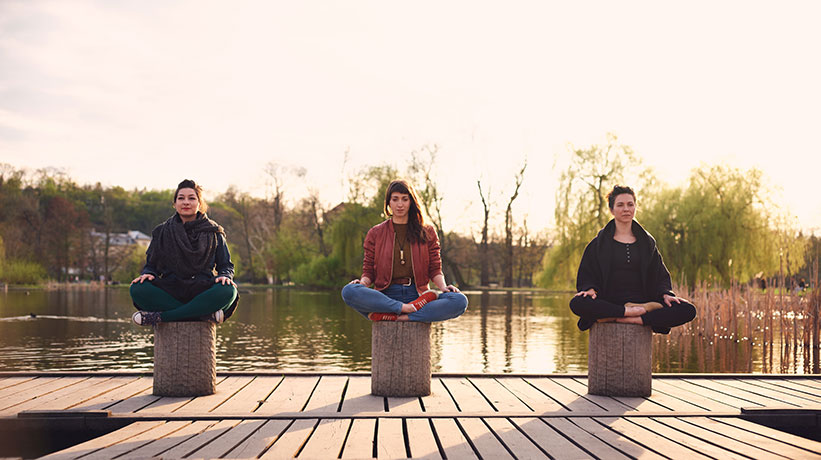How Long Should You Meditate For? All You Want To Know
To begin with, how long should you meditate for? Meditation practice for 40–45 minutes per day is typically advised by mindfulness-based clinical interventions like Mindfulness-Based Stress Reduction (MBSR).
20 minutes, twice daily, is frequently advised by the Transcendental Meditation (TM) tradition. Interventions built on the Relaxation Response frequently suggest 20-minute meditation sessions.
This suggests that meditation is comparable to exercise. There is no ideal amount of time to exercise, just as there is no ideal duration for meditation. The duration of your practice, whether it be meditation or physical exercise, should be long enough to challenge you, but not so long that you become discouraged or worn out.
For more information, keep reading.
Table of Contents
How Much Time Should You Spend Meditating To See Results?
According to a 2018 study published in Behavioural Brain Research, meditating for 13 minutes a day for eight weeks led to decreased negative mood state, enhanced attention, working memory, recognition memory, and decreased state anxiety. The study also discovered that participants who practiced meditation for eight weeks saw results that were more significant than those who practiced it for only four.
The consensus appears to be that you should aim for at least 10 minutes a day of meditation, even though it is not an exact science, in order to experience its benefits. Each person will react differently, so it’s important to experiment with longer meditation sessions if 10 minutes does not seem to be helping you.
How Much Time Should A Beginner Spend Meditating?
Beginners may want to start out by meditating for at least five minutes each day. You can begin with just five minutes to get used to it. It will also assist you in committing to your meditation practice without putting undue pressure on yourself, which lowers stress levels and makes meditation simpler for beginners.
You’ll also be able to better determine when to meditate if you start out with just five minutes each day. Try starting with less time and gradually increasing it by one minute each week until you reach the desired duration if five minutes seems excessive.
How Long Should One Meditate To Reduce Anxiety?
An anxiety sufferer may benefit from mindfulness-based stress reduction (MBSR), a type of meditation. This program, which was created by Jon Kabat-Zinn and is based on research, consists of daily 45-minute sessions and is intended to be completed over the course of eight weeks.
A 2015 study published in the Journal of Psychosomatic Research reported on a systematic review of MBSR.2 Researchers found that “results suggested large effects on stress, moderate effects on anxiety, depression, distress, quality of life, and small effects on burnout.”
MBSR requires participants to dedicate 45 minutes per day to mindfulness practice, which may not be feasible for all individuals, despite the positive study results. Another strategy is to break up your 45-minute practice session into smaller 10-minute sessions spread out throughout the day.
How Long Does Meditation Take To Alter The Brain?
The research is still in its early stages in terms of how long your brain changes. However, a study published in the journal Neuroscience and Biobehavioral Reviews found that mindfulness training can actually cause physical changes in the brain when used over a period of time.
Nevertheless, not all teachers of meditation would concur that it is important to consider how long it takes for meditation to alter your brain. Instead, they contend that even a short amount of time per day can have positive effects right away and make you more mindful overall.
How Frequently Must You Meditate?
We are practicing a skill when we meditate, just like we would when we exercise. The skill improves with use as we put it into practice more and more. Therefore, if you can, it’s best to meditate every day. There is no need for days off because, in contrast to exercise, you won’t feel sore afterward. Having said that, if you’re not able to meditate daily it’s important to be gentle with yourself and not beat yourself up for having “inadequate discipline.”
Whether we meditate daily or less frequently, we should make a commitment to doing so. (once more, like physical activity!) We can become more intimately familiar with our minds when we maintain that regularity over extended periods of time.
Is Ten Minutes Of Meditation Enough?
If you’re wondering whether just 10 minutes of meditation will suffice, it depends on your objectives and preferred meditation technique. Ten minutes should be sufficient if you’re just starting out and want to de-stress.
However, up to 30 minutes may be preferable if you want to concentrate more on calmness and improved concentration because you’ll have time for some light stretches and breathing exercises. No matter how long you choose to meditate, make sure you do it every day. This will help train your mind to be more awakened throughout the day. But, can you meditate lying down?

How Often Should You Meditate Each Day?
It would be ideal if you practiced meditation at least once a day. The most crucial area for beginners to concentrate on is consistency. According to studies, those who regularly practice meditation are more likely to stick with it and reap its full rewards.
How Often Should You Meditate?
Your schedule, among other things, will determine the ideal time of day for meditation. Ensure that you select a time when you are most comfortable and likely to stick to your routine.
Is it preferable to meditate as soon as you wake up in the morning? Depending on the type of meditation you’re attempting to practice, yes and no.
For two reasons, morning meditation is preferred by many people: first, it’s a nice way to start the day by being mindful and practicing self-care; second, it gives you some alone time before getting started with your daily routine.
On the other hand, because it’s a quiet time to practice, you might prefer to meditate in the afternoon or at night. Additionally, this aids in balancing out all the information you’ve been consuming throughout the day.
Overall, there are advantages to practicing meditation at various times of the day. See what works best for you among the various times you try.
Want to know the purpose of mediation?
Sitting For Long Hours In Meditation
The idea of meditating for several hours at a time appeals to some people. They might have drawn inspiration from pictures of Buddhist monks or nuns meditating blissfully for extended periods of time without pausing. Most people who sit for extended periods of time have been gradually exercising for months or even years. Intensive sitting requires a lot of practice and discipline, especially for those who meditate alone. If you feel compelled to meditate as intensely as these nuns and monks do, you must either enroll in a structured meditation retreat led by knowledgeable teachers or make contact with a qualified meditation teacher to ensure that you have the right guidance.
Setting aside time specifically for meditation has the benefit of reducing distractions and giving the mind enough time to truly settle into mindfulness and awareness. This is often pictured as a jar of turbulent, murky water. The impurities sink to the bottom and the water becomes clear after the jar is set down and the contents have had some time to settle. The mind is no different. The length of a retreat can range from a few hours to many years! You can decide what will be most helpful to you with the assistance of a good teacher.
The Benefits Of Meditation Arise From Making The Most Of Each Moment
Whether you prefer brief or extended meditation sessions, the advantages of meditation are immeasurable. Try making the most of each practice session rather than stressing about how many minutes, hours, or years you should sit. Quantity is not important; quality is. Select a time that is convenient and noise- and interruption-free. Although mornings are frequently advised, you can also incorporate short meditations throughout the day or make evenings your preferred time. Before your session begins, make sure that you are seated comfortably. You can practice a variety of beneficial meditation techniques. If sitting meditation becomes too tiresome, try walking meditation instead. The whole point of meditation is to remain enjoyable and fresh. But, can you meditate with music?
You can change your life and get the outcomes you want by practicing sitting meditation every day. There is no kindergarten or graduation in meditation, unlike in education. It’s similar to brushing your teeth for many people in that they find it difficult to imagine going a day without it. And you do it because it’s enjoyable, makes you feel better than skipping it would, and is undeniably good for you.
The Mindworks meditation courses are among the best online meditation resources available to assist you in navigating the highways and byways of meditation. It is jam-packed with excellent tools that can quickly advance you from a novice to an experienced meditator. There are even excellent courses available to teach you how to meditate.
If you’ve read this far, you must be curious about the practice of meditation and its outcome, which is the sensation of lasting happiness and wellbeing. You’re in the right place.
Sincere meditation practices cultivate our innate capacity for joy and awareness. Practice success depends on clear, progressive instructions. You can take advantage of all the benefits of a regular meditation practice thanks to Mindworks’ 9-level Journey to Well-Being and other motivational courses.
How Long You Should Meditate For Depends On Your Experience?
Even though it may seem simple, maintaining long periods of silence is more difficult than it may seem, especially since you need to be aware of what is going on around you rather than be lost in thought.
Try to set aside some time each day for meditation, but be aware that at first, your mind might not be prepared to focus for longer sessions. Starting out, five minutes a day should be more than enough. You can gradually extend the duration of your mindfulness practice when you’re ready. Being able to focus can be challenging, so as a beginner, you might try practicing a few times a day for a short period of time to get used to the meditation experience.
You can try practicing for up to 20 minutes per session once you’ve established some degree of mental control during meditation. After a few minutes of warming up, you’ll notice that you’re ready to move on to a deep breath when you can focus.
More seasoned meditators can go beyond 30 minutes without losing focus after a few seconds. Of course, forcing yourself to meditate for a long period of time when you are just starting out will only be detrimental. Shorter sessions are preferable. Keep in mind that anyone who can sit still for an extended period of time has trained steadily over many years to reach their current level. Don’t be disheartened; instead, consider what practice will make possible.
Do not be concerned with the length of your meditation sessions. Great results will come from your dedication to the practice, which will also motivate you to keep improving. What’s more important when you’re learning to meditate and just starting out is frequency. You’ll be more successful if you practice consistently and for a prolonged period of time.
Finally, if you attend a meditation retreat, you’ll probably find yourself sitting in silence for hours at a time, several times a week. Thus, your commitment and goal will also influence the ideal length. Of course, you can always start with a free meditation app like Declutter The Mind. See more about What Is Spiritual Meditation?
Why Do Some People Stop Meditating?
With the justification that they don’t have the time to devote to it, many people never even consider beginning meditation. Others merely believe that only yogis or hippies can meditate. Such claims are false, as you might have guessed. Everyone can benefit from meditation; all you need to do is practice it properly to reap the rewards. But fortunately, it’s easy to learn the right way to meditate by following guided meditations.
The truth is that after some time, many people feel they cannot meditate because they grow bored or weary of doing it. In fact, when practicing for longer periods of time, it can be very difficult to begin meditating. You’re attempting to manage your mind and thoughts, which you might be surprised to learn is not something we are very accustomed to doing. But will longer periods of meditation be necessary before you make any progress in your meditation practice?
Your choice of meditation teachers may also influence how long you meditate for and whether you continue with your practice after a while. When guided by a qualified individual, mindfulness meditation can be calming. It might be simpler for you to meditate for longer periods of time if you learn to incorporate meditation into your daily life when you’re experiencing stress at work. A meditation app like Declutter The Mind can allow you to meditate at home where you feel most comfortable, such as a bed, on a couch, or in a bean bag chair. You’re more likely to try a mindfulness practice for a long time and less likely to give up on it if you feel at ease in your surroundings.
You’ll discover that meditation is more approachable than you might have imagined. The duration of the meditation practice, as well as how to gauge your progress accurately, are all covered in the following paragraphs.
Types Of Meditation
Depending on the style you use, a meditation session may last a certain amount of time. Consider the common types of meditation:
Breath Awareness
Using deep inhalations and exhalations to expel bothersome or unimportant thoughts, breath awareness is a type of meditation that concentrates on breathing. During your session, you can organize your thoughts and create emotional stability thanks to the goal of this meditation technique: preventing mind wandering.
Guided
A guided meditation session is one that is led by an instructor, either in person during a meditation class or through prerecorded audio that you can access online or through a smartphone app. A soothing voice from the speaker leads the listener through their meditation as they speak. They might tell the meditator to hold their breath for a predetermined period of time, form particular mental images, or perform a body scan (imaginarily traveling through the different parts of your body).
Kundalini
Kundalini meditation, a well-known form of yoga, awakens and disperses the body’s dormant energy through a combination of deep breathing, mantras, and hand gestures.
Loving-kindness
Metta, or loving-kindness meditation, centers compassion by guiding the meditator to feel love and kindness for everyone in their life, including people they might otherwise regard as their enemies. The intention of the meditation is to develop feelings of love and kindness that can subdue stressful thoughts and emotions.
Mindfulness
An approach to meditation known as “mindful meditation” emphasizes the importance of being fully present and conscious of both your body and your surroundings. This type of meditation can involve a quick scan of your current environment, whether it be in public or at home, or a quiet, in-depth examination of your space. In order to achieve a relaxed state of awareness without passing judgment on your thoughts, body, or surroundings, you must practice mindfulness meditation.
Progressive
The goal of progressive relaxation, also known as body scan meditation, is to search the body for any tension or stress-related areas. Users of this meditation technique concentrate on body awareness, starting at one end, slowly working their way through, and releasing each physical stress point as they identify it.
Transcendental
Maharishi Mahesh Yogi invented transcendental meditation, which makes use of silent mantra repetition to assist in transcending oneself. This method of meditation gradually introduces thought bubbles into the mind, resulting in a relaxed and stress-free state.
Vipassanā
Vipassana meditation, which has roots in early Buddhism, makes use of concentration and awareness to help clear the mind of impurities and remove illusions that cloud our perception of reality. The main objectives of vipassana, a form of Buddhism popular among Buddhists in some parts of Southeast Asia, are liberation and self-transformation. In Buddhism, vipassanā (also spelled vipaśyanā) is a term that means “insight” or “without seeing.”
Walking
A person who practices walking meditation alternates between long periods of sitting meditation (also referred to as zazen) and movement. For a predetermined period of time, the practitioner walks a short distance while hyper-focusing on each step’s physical sensations and motions of the body.
Zen
Zen meditation is a Buddhist practice that gives the practitioner insight into how their mind functions. With the aid of focused observation, this type of meditation, which is a common spiritual practice in Buddhism, enables the meditator to process and address fundamental issues while also developing compassion.
The Bottom Line
It is reasonable to anticipate that meditation will be beneficial if you set aside 10 minutes each day for it. 20 minutes would probably be more helpful, it’s true. But keep in mind that if you make a commitment to meditate for 10 minutes each day, you can always extend that to 20 minutes if you feel so inclined once you reach 10 minutes.
It matters more to most of us how frequently we sit down to meditate than how long. To help create a regular meditation habit, remember the following tips:
- Keep a record of how frequently you meditate. Use a tracking app or check dates on the calendar with a checkmark. You can hold yourself accountable without putting in a lot of extra effort by doing this.
- Never forget that it’s okay to miss a day. Possessing some self-compassion is a necessary component of meditation. Instead of dwelling on the one day when you were unable to meditate, pay attention to how many times you were able to do so this week or this month.
- Reduce your daily target meditation time if you find that you are not consistently meditating the recommended amount of time. This will relieve some of the pressure.
Remember these guidelines when choosing how frequently or for how long to meditate. You’ll increase your chances of starting and keeping up a regular, beneficial meditation practice if you do this.
I appreciate you reading.





